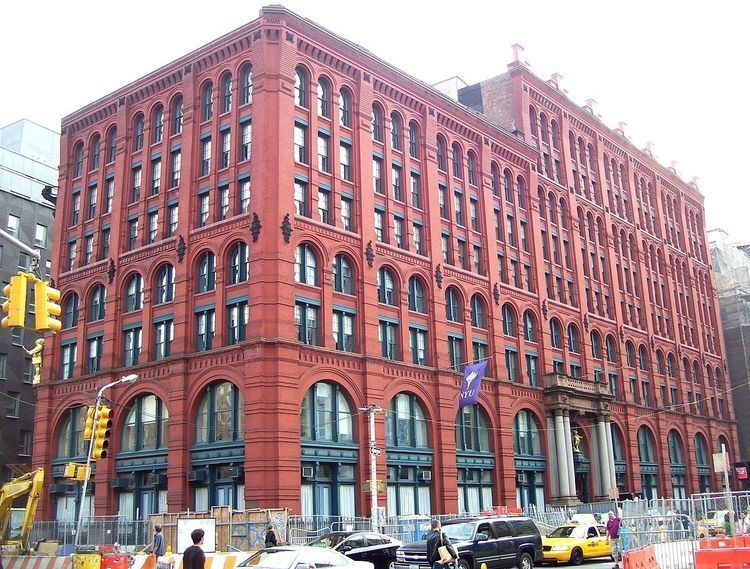Built 1885–86 Designated NYCL April 12, 1983 Opened 1885 Added to NRHP 21 July 1983 | NRHP Reference # 83001740 Area 3,642 m² Phone +1 212-993-5858 | |
 | ||
Address 295 Lafayette St, New York, NY 10012, USA Architectural styles Similar Saddle River County P, Headless Horseman Hayrides, Franklin D Roosevelt President, Angel Orensanz Center, Washington Square Village | ||
Emily smith living large puck building
The Puck Building is a historic building located in the Nolita neighborhood of Manhattan, New York City. It occupies the block bounded by Lafayette, Houston, Mulberry and Jersey Streets.
Contents
- Emily smith living large puck building
- Puck building penthouses
- History
- Tenants
- In popular culture
- References
An example of the German Rundbogenstil style of Romanesque Revival architecture, the building was designed by Albert Wagner, and was constructed in two parts. The north section was built in 1885–86, and the south addition in 1892–93. The front of the building – on Lafayette Street – was relocated in 1899 when the street – then called Elm Place – was widened, this was supervised by Herman Wagner. The building was rehabilitated in 1983–84 and further renovated in 1995 by Beyer Blinder Belle. The building sports two gilded statues by sculptor Henry Baerer of Shakespeare's character Puck, from A Midsummer's Night Dream, one on the northeast corner at Houston and Mulberry, and one over the main entrance on Lafayette.
The building is located at the northwestern corner of Manhattan's NoLIta neighborhood, bordered by SoHo and the NoHo section of Greenwich Village. It is owned by Kushner Properties, the company of Charles Kushner, a major donor to Democratic politicians in New Jersey, and his son Jared Kushner, the owner of The New York Observer.
Puck building penthouses
History
The building was constructed as the printing facility of J. Ottmann Lithographic Company as a seven-story structure, with a nine-story structure added on in 1892.
The building was the longtime home of Puck magazine, which gave the building its name; Founded in St. Louis in 1871, the magazine moved into the building in 1887 and remained there until it ceased publication in 1918.
A June 1887 fire caused significant damage, estimated as high as $30,000, including water damage to the editorial rooms used by Puck magazine. A fire in November caused $50,000 in damage after a can of turpentine caught on fire inside a finishing room where workers were producing Christmas cards.
The building later housed numerous independent printing firms and related printing services such as typesetters and a printing ink company, Superior Printing Ink. The odor of printing ink permeated the building for many years. An office stationery company, S. Novick & Son, once occupied the second floor. Notable among that firm's salesmen was Alger Hiss, the former Assistant Secretary of State, who was brought down in a spy scandal in the 1950s.
The Serra family bought the building in 1978 and allowed the building to empty out as tenants left over the years as their leases expired. A proposed 1981 conversion of the building eliminated the inclusion of residential space based on the economics of paying displaced commercial tenants a fee of $9 per square foot. The building reopened in April 1983 after an $8 million renovation and restoration project that created condominium spaces for businesses primarily related to the arts.
Owner Jared Kushner sought approval from the Landmarks Preservation Commission to erect six penthouse apartments at the top of the red-brick building. After initially being turned down in October 2011, Kushner made two modifications and his plans were approved. The first of the six units closed in May 2014, selling for $28 million.
Tenants
In the 1980s, the Puck Building was the original home of Spy Magazine. Starting in 1986, the building housed the Manhattan Center of Pratt Institute. Pratt used the additional space for computer and technical labs for the School of Computer, Information, and Library Science (SCILS).
Since 2004, the building has been used by New York University for the Wagner Graduate School of Public Service and the department of sociology.
The building contains both office and retail space as well as ballrooms for large events on both the top and ground floors. The Skylight Ballroom can accommodate 250 guests, while the Grand Ballroom can fit up to 1,000.
The retail space was added when the building underwent a large-scale renovation beginning in October 2011.
In 2011, REI opened a 35,000-square-foot (3,300 m2) store spanning the building's first three levels. The renovation was designed by architects Callison and includes an area that showcases the history of the Puck Building.
